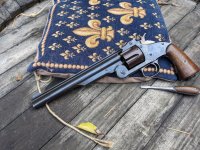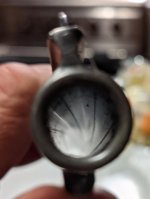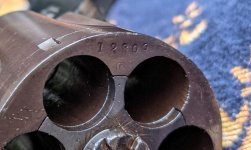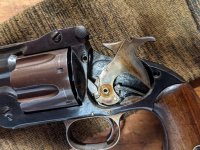a few weeks ago i bought this smith and wesson 44 RUSSIAN. What do you think ? i am new member of the forum i don't speak english veru well . Serial number is 12XXX
You are using an out of date browser. It may not display this or other websites correctly.
You should upgrade or use an alternative browser.
You should upgrade or use an alternative browser.
old old RUSSIAN ?
- Thread starter jmla112
- Start date
Register to hide this ad
Welcome to the forum. That is a beautiful gun! And I understood you just fine, which I can't say for some of the native speakers on here.
OLDSTER
Member
Hi from North Dakota 
Welcome to the greatest forum on Smith and Wesson firearms on the web.
Now about that pistol.
Well done lad. I'd like to have one as nice as that one. When I first looked at your pictures I thought I was looking at a spider web in the barrel. Much relieved to see it was only light at the end of the tunnel.
Now about that pistol.
Well done lad. I'd like to have one as nice as that one. When I first looked at your pictures I thought I was looking at a spider web in the barrel. Much relieved to see it was only light at the end of the tunnel.
Welcome to the forums from the cotton and peanut covered plains of the Wiregrass! Your gun is a beautiful example of a Russian model. The purple color of the cylinder may indicate it was refinished at some point in its life. Whoever did the work did a fine job. Congratulations!
Welcome! Technically, that would be called a Model 3 Russian, 1st Model even though it has the frame swell and larger trigger pin. The "Old Old" name is archaic and confusing at best, but the fact that a 2nd Model is called a 1st Model is also confusing. It seems that during the contract order for the 1st Model, a change was made to increase the size of the trigger pin and to add the notch to the hammer to lock the top latch in place when the hammer was at rest. Your revolver would have been part of the 20,000 contract guns made for Russia, most likely shipped in 1872. This Russian contract model is very rare in the US, with only few known.
The stocks of the gun are worn from sanding and are under-sized, not fitting the frame. The finish looks too fresh for original, since original finish guns from this era had a higher polish and yours looks flat. For some reason, re-blued guns often have a cylinder that turns plum color over time. I believe it is due to the metallurgy being different in the cylinders than the rest of the gun and not taking a blue as well. Adding nickel to steel, for example, toughens the metal but also makes it much more difficult to color.
Bottom line is that you have a gun that is has not been mistreated or damaged in use. It has very smooth metal and most likely just lost its bluing over time. Fortunately, the refinish did not include a buffing wheel since the stamping and the edges remain sharp, that coupled with the rarity means you still have a very nice and significant Smith & Wesson revolver.
I forgot to add this older Supica video showing a sharp no finish Model 3. Prices are old, so it might be worth more now.
[ame]https://www.youtube.com/watch?v=GCvyc__wLIQ[/ame]
The stocks of the gun are worn from sanding and are under-sized, not fitting the frame. The finish looks too fresh for original, since original finish guns from this era had a higher polish and yours looks flat. For some reason, re-blued guns often have a cylinder that turns plum color over time. I believe it is due to the metallurgy being different in the cylinders than the rest of the gun and not taking a blue as well. Adding nickel to steel, for example, toughens the metal but also makes it much more difficult to color.
Bottom line is that you have a gun that is has not been mistreated or damaged in use. It has very smooth metal and most likely just lost its bluing over time. Fortunately, the refinish did not include a buffing wheel since the stamping and the edges remain sharp, that coupled with the rarity means you still have a very nice and significant Smith & Wesson revolver.
I forgot to add this older Supica video showing a sharp no finish Model 3. Prices are old, so it might be worth more now.
[ame]https://www.youtube.com/watch?v=GCvyc__wLIQ[/ame]
Last edited:
Dang it!...I don't think I ever felt a burning desire to own a top break S&W, and now suddenly I do...Welcome to the forums...I'm sure we're all curious to know your location, and how you acquired that beauty... ...Ben
...Ben
opoefc
US Veteran
I'm not convinced that the gun's been refinished. I've seen too many antique S&Ws that have had their cyinders turn dark over time and were original guns. Regardless, that a very nice find and an outstanding example. Ed
I'm not convinced that the gun's been refinished. I've seen too many antique S&Ws that have had their cyinders turn dark over time and were original guns. Regardless, that a very nice find and an outstanding example. Ed
I think like you. I examined it with a watchmaker's magnifying glass and saw no trace of polishing. it is impossible to reblue (refinish?) without leaving a mark on the angles. only the stocks are used
merl67
Member
Welcome to the forum! What a nice first post. I would be absolutely thrilled to find that gun in one of my local sources!
opoefc
US Veteran
A very skilled polisher can refinished a gun and not leave any detailed indications of their work if the gun has no blemishes, pits or other damages that have to be polished out, and therefore leave polishing marks. The old time S&W factory gun finishers could repolish and refinish a S&W and I would defy anyone to point out any evidence of a refinish ( excluding the refinishing stamps applied to the grip frame ) . Ed
Last edited:
Masterpiece
Member
JMLA112, are your stocks numbered to the gun ?
Hi Ed,
Yes they are....See JMLA112's photos in Post#6...He's posted very clear photos of the Cyl. Face as well as the Right Stock Panel showing the Serial Number to be (12309)...Hope this helps until the OP gets back to you!!
max503
Member
How do you say "drool" in your language?
That gun makes me drool. I would love to have one like it. And if it was mine I would shoot it if I could.
I would love to have one like it. And if it was mine I would shoot it if I could.
That gun makes me drool.
Last edited:
a few weeks ago i bought this smith and wesson 44 RUSSIAN. What do you think ? i am new member of the forum i don't speak english veru well . Serial number is 12XXX
What do I think?
I think that is a beautiful old #3 that anyone on the forum would love to have. I would sure like to see that one in person.
Congratulations.
Chief Wiggums
Member
Hi from North Dakota
another hello from a former N Dakota resident (Fargo)
BAVER !How do you say "drool" in your language?
That gun makes me drool.I would love to have one like it. And if it was mine I would shoot it if I could.
First shoot 25 mètres 05 /09/2021 with black powder VECTAN PNF2
Attachments
Last edited:







